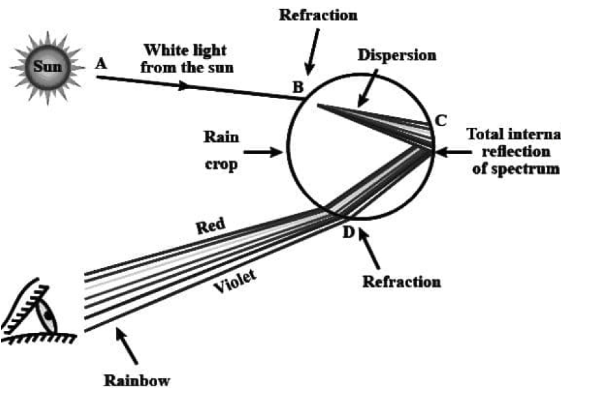
What is meant by dispersion of white light? Describe the formation of a rainbow in the sky with the help of a diagram.
Answer
483.9k+ views
Hint: In order to understand this problem we should first understand about prism which will help us to understand dispersion. A prism is a three-dimensional solid object with two identical ends. It's the result of the flat faces, similar bases, and equal cross-sections coming together. Without the bases, the prism's faces are parallelograms or rectangles. The prism's bases could be a triangle, square, rectangle, or any other n-sided polygon.
Complete answer:
When white light passes through a prism, it splits into seven constituent colours, which is known as dispersion. When white light passes through a glass prism, it separates into its spectrum of colours (in order violet, indigo, blue, green, yellow, orange, and red), a process known as dispersion.
The rainbow is formed when sunlight splits due to water drops suspended in the air, resulting in a band of seven colors. In the sky, water droplets act as tiny prisms. When sunlight enters these small droplets, it undergoes internal reflection and also refracts these rays, resulting in a rainbow band of seven colors. Rainbows always form in the opposite direction of the sun.

Note: The varying degrees of refraction experienced by different colors of light cause dispersion. In a vacuum, different colors of light move at the same speed, but in a refracting material, they travel at different rates. Violet light travels at a much slower rate than red light.
Complete answer:
When white light passes through a prism, it splits into seven constituent colours, which is known as dispersion. When white light passes through a glass prism, it separates into its spectrum of colours (in order violet, indigo, blue, green, yellow, orange, and red), a process known as dispersion.
The rainbow is formed when sunlight splits due to water drops suspended in the air, resulting in a band of seven colors. In the sky, water droplets act as tiny prisms. When sunlight enters these small droplets, it undergoes internal reflection and also refracts these rays, resulting in a rainbow band of seven colors. Rainbows always form in the opposite direction of the sun.

Note: The varying degrees of refraction experienced by different colors of light cause dispersion. In a vacuum, different colors of light move at the same speed, but in a refracting material, they travel at different rates. Violet light travels at a much slower rate than red light.
Recently Updated Pages
Master Class 12 Business Studies: Engaging Questions & Answers for Success

Master Class 12 Economics: Engaging Questions & Answers for Success

Master Class 12 English: Engaging Questions & Answers for Success

Master Class 12 Maths: Engaging Questions & Answers for Success

Master Class 12 Social Science: Engaging Questions & Answers for Success

Master Class 12 Chemistry: Engaging Questions & Answers for Success

Trending doubts
Who was the first woman to receive Bharat Ratna?

Write a letter to the principal requesting him to grant class 10 english CBSE

Why is there a time difference of about 5 hours between class 10 social science CBSE

What is the median of the first 10 natural numbers class 10 maths CBSE

The Equation xxx + 2 is Satisfied when x is Equal to Class 10 Maths

Discuss the main reasons for poverty in India




